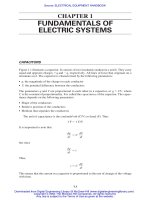Electrical safety handbook
Bạn đang xem bản rút gọn của tài liệu. Xem và tải ngay bản đầy đủ của tài liệu tại đây (1.96 MB, 328 trang )
TS
NOT MEASUREMENT
SENSITIVE
DOE-HDBK-1092-98
January 1998
DOE HANDBOOK
ELECTRICAL SAFETY
U.S. Department of Energy
Washington, D.C. 20585
AREA SAFT
DISTRIBUTION STATEMENT A. Approved for public release; distribution is unlimited.
More ebooks : />
DOE-HDBK-1092-98
This document has been reproduced directly from the best available copy.
Available to DOE and DOE contractors from the Office of Scientific and
Technical Information, P.O. Box 62, Oak Ridge, TN 37831; (423) 576-8401.
Available to the public from the U.S. Department of Commerce, Technology
Administration, National Technical Information Service, Springfield, VA
22161; (703) 487-4650.
Order No. DE98001290
More ebooks : />
DOE-HDBK-1092-98
CONTENTS
1.0
INTRODUCTION
2.0
GENERAL REQUIREMENTS
3.0
ELECTRICAL PREVENTIVE MAINTENANCE
4.0
GROUNDING
5.0
SPECIAL OCCUPANCIES
6.0
REQUIREMENTS FOR SPECIFIC EQUIPMENT
7.0
WORK IN EXCESS OF 600 VOLTS
8.0
TEMPORARY WIRING
9.0
ENCLOSED ELECTRICAL/ELECTRONIC EQUIPMENT
10.0 RESEARCH AND DEVELOPMENT
11.0 REFERENCES
APPENDIX A. DOE MODEL ELECTRICAL SAFETY PROGRAM
APPENDIX B. ACRONYMS AND DEFINITIONS
APPENDIX C. WORK MATRICES-EXAMPLES
APPENDIX D. REGULATION MATRICES
APPENDIX E. FUTURE CHAPTERS
More ebooks : />
DOE-HDBK-1092-98
This page left blank intentionally.
More ebooks : />
DOE-HDBK-1092-98
FOREWORD
1. This Department of Energy (DOE) Handbook is approved for use by the Office of
Environment, Safety, and Health and is available to all DOE components and their contractors.
2. Specific comments (recommendations, additions, deletions, and any pertinent data) to
enhance this document should be sent to:
Patrick Tran
Office of Environment, Safety and Health
Office of Worker Safety and Health
Bellemead Building
U. S. Department of Energy
19901 Germantown Road
Germantown, MD 20874-1290
3. The DOE Electrical Safety Handbook replaces the DOE Electrical Safety Guidelines that was
originally issued in 1993. DOE handbooks are part of the DOE directives system and are
issued to provide supplemental information regarding the DepartmentÕs expectations for
fulfilling its requirements as contained in rules, Orders, notices, and regulatory standards. The
handbooks may also provide acceptable methods for implementing these requirements.
Handbooks are not substitutes for requirements, nor do they replace technical standards that
are used to describe established practices and procedures for implementing requirements.
4. This document contains DOE developed explanatory material in support of OSHA regulations
and nationally recognized electrical safety related standards and other information. This
document was revised to include electrical safety for enclosed electrical and electronic
equipment, research and development, and the latest editions of 29CFR 1910 and 1926,
National Electrical Code, National Electrical Safety Code, and National Fire Protection
Association 70E as of September 1997.
5. Topics that are being considered for future development and inclusion in the next update of
this document are included in Appendix E.
More ebooks : />
DOE-HDBK-1092-98
This page left blank intentionally.
More ebooks : />
DOE-HDBK-1092-98
CONTENTS
1.0 INTRODUCTION ................................................................................................... 1-1
1.1 PURPOSE .................................................................................................. 1-1
1.2 SCOPE ....................................................................................................... 1-1
1.3 AUTHORITY HAVING JURISDICTION (AHJ) .......................................... 1-2
1-1
1-i
More ebooks : />
DOE-HDBK-1092-98
This page left blank intentionally.
1-ii
1-2
More ebooks : />
Free Download / Subscription Industrial and Engineering Magazines
or get directly on individual magazine below :
More free magazines ...
More ebooks : />
DOE-HDBK-1092-98
1.0 INTRODUCTION
1.1 PURPOSE
Electrical Safety Handbook presents the Department of Energy (DOE) safety standards for DOE
field offices or facilities involved in the use of electrical energy. It has been prepared to provide a
uniform set of electrical safety guidance and information for DOE installations to effect a reduction
or elimination of risks associated with the use of electrical energy. The objectives of this handbook
are to enhance electrical safety awareness and mitigate electrical hazards to employees, the public,
and the environment.
1.2 SCOPE
This handbook provides general information to enhance understanding of DOE Orders, national
codes, national standards, local, state, and federal regulations. This handbook shall not supersede
more stringent requirements in those applicable codes, standards, and regulations.
Each entity should reference its contract documents and determine what legal requirements are to be
followed in the area of electrical safety. These requirments may vary from locaction to location. In
this document, “shall” refers to requirements from regulatory standards such as OSHA and relevant
DOE Orders that may or may not apply to your specific location. “Should ” refers to guidance from
consensus standards such as the National Electrical Code (NFPA 70), National Electrical Safety
Code (NESC, ANSI C2), and Electrical Safety Requirements for Employee Workplaces (NFPA
70E) which may or may not apply to your specific location (depending upon your contractual
requirements). No section or portion of this document is intended to stand alone. Each section or
portion interacts with others that are appropriate to support referenced material.
The design of new facilities shall conform to relevant DOE Orders and should conform to industry
recognized engineering design standards. Existing facilities should evaluate their systems and
operations in relation to this handbook, applicable DOE Orders, national codes, national standards,
local, state, and federal regulations, to determine if they comply or if a safety problem exists. If the
evaluation determines that a safety risk exists, corrective actions should be initiated to bring the
systems or operations into compliance with current standards. In the case of a major renovation of
an existing facility, the modification shall comply with current standards.
Existing facilities shall conform to relevant DOE Orders and should comply with the National
Electrical Code (NFPA 70), National Electrical Safety Code (NESC, ANSI C2), and Electrical
Safety Requirements for Employee Workplaces (NFPA 70E). The OSHA standards have specific
requirements that shall apply to all electrical installations and utilization equipment regardless of
when they were designed or installed and identify other mandatory provisions and specify effective
dates. Installations in compliance with the code at the time of design or installation (code of record),
do not need to be upgraded to the updated code unless required to correct a known hazard or a major
modification is being performed.
This handbook is being provided to identify those DOE Orders, national codes, national standards,
local, state, and federal regulations that will provide employees with guidance on requirements
1-1
More ebooks : />
DOE-HDBK-1092-98
pertaining to electrical systems. It is the responsibility of each site to evaluate compliance with the
above requirements.
1.3 AUTHORITY HAVING JURISDICTION (AHJ)
In states and municipalities, an official (electrical inspector, engineer, or equivalent qualified
individual) is usually designated as the electrical Authority Having Jurisdiction (AHJ). The AHJ
should possess such executive ability as is required for performance of the position, and should have
thorough knowledge of standard materials and work practices used in the installation, operation,
construction, and maintenance of electrical equipment. The AHJ should, through experience or
education, be knowledgeable of the requirements contained in the OSHA standards, the National
Electrical Code, the National Electrical Safety Code, DOE requirements, and other appropriate local,
state, and national standards. The AHJ should be responsible to interpret codes, regulations and
standards, and approve equipment, assemblies, or materials. If the AHJ needs to address items
outside their electrical expertise, such as fire, confined space, fall protection, or like issues, the AHJ
should consult with cognizant experts before a decision is reached. The AHJ may permit alternate
methods where it is assured that equivalent objectives can be achieved by establishing and
maintaining effective safety equal to or exceeding established codes, regulations, and standards.
In DOE, levels of authority exist that serve the function of the AHJ. The AHJ may be the contracting
officer, such as an area manager. This person may choose to delegate authority to an individual or
organization within his or her control. The authority may reside with a safety or facilities department.
The field office manager or designated representative may act as a higher level of authority. The
authority may begin with an electrician and proceed through various levels of supervision to
management (as shown in Fig. 1-1).
DOE contractors should establish lines of authority within their organizations. It is important that
a line of authority be established, documented, and recognized. The limits of the authority and
recognition of higher authority should be delineated.
1-2
More ebooks : />
DOE-HDBK-1092-98
DOE EH-1
DOE OPS
DOE Site Office
Site Manager
Health & Safety Division Manager
Health & Safety Department Manager
Health & Safety Professional
(e.g., Fire Protection Manager or
Electrical Program Manager)
Division Manager
Department Manager
Supervisor
Employee
Fig. 1-1.
NOTE: The titles in Fig. 1-1 will vary from site to site.
1-3
More ebooks : />
DOE-HDBK-1092-98
This page left blank intentionally.
1-4
More ebooks : />
DOE-HDBK-1092-98
CONTENTS
2.0
GENERAL REQUIREMENTS .............................................................................. 2-1
2.1 ELECTRICAL MAINTENANCE OR REPAIRS ............................................ 2-1
2.1.1 WORK ON ENERGIZED/DEENERGIZED
ELECTRICAL EQUIPMENT ......................................................... 2-1
2.1.2 CONSIDERATIONS FOR WORKING ON
ENERGIZED SYSTEMS AND EQUIPMENT ................................ 2-1
2.1.3. SAFETY WATCH RESPONSIBILITIES
AND QUALIFICATIONS ............................................................... 2-3
2.2 BASIC SAFEGUARDS ................................................................................. 2-3
2.3 RESPONSIBILITIES ..................................................................................... 2-4
2.3.1 MANAGEMENT RESPONSIBILITIES .......................................... 2-4
2.3.2 EMPLOYEE RESPONSIBILITIES ................................................ 2-4
2.4 REVIEWS/INSPECTIONS ............................................................................ 2-4
2.5 APPROVAL OF ELECTRICAL EQUIPMENT .............................................. 2-6
2.6 CODES, STANDARDS, AND REGULATIONS ............................................ 2-7
2.7 GROUND FAULT CIRCUIT INTERRUPTERS ............................................. 2-8
2.7.1 HOW A GFCI WORKS .................................................................. 2-8
2.7.2 USES ............................................................................................. 2-9
2.8 TRAINING AND QUALIFICATIONS OF QUALIFIED WORKERS ............ 2-10
2.8.1 FORMAL TRAINING AND QUALIFICATIONS .......................... 2-10
2.8.2 TRAINING OF SAFETY PERSONNEL ...................................... 2-12
2.9 WORKING SPACE AROUND ELECTRICAL EQUIPMENT ................... 2-12
2.9.1 ELECTRICAL EQUIPMENT RATED AT 600 VOLTS OR LESS 2-12
2.9.2 ELECTRICAL EQUIPMENT RATED OVER 600 VOLTS ........... 2-14
2.10 IDENTIFICATION OF DISCONNECTION MEANS ................................. 2-15
2.10.1 DISCONNECTING MEANS ........................................................ 2-15
2.10.2 PANELBOARD CIRCUIT DIRECTORIES .................................. 2-15
2.10.3 ENCLOSURE LABELING ........................................................... 2-15
2.10.4 LOAD LABELING ....................................................................... 2-15
2.10.5 SOURCE LABELING .................................................................. 2-15
2.11 WORK INSTRUCTIONS .......................................................................... 2-15
2.11.1 SAFE WORK INSTRUCTIONS AND SUPERVISION ................. 2-15
2.11.2 WORK INSTRUCTIONS .............................................................. 2-16
2.11.3 WORK PLANNING ..................................................................... 2-17
2.12 ELECTRICAL PERSONAL PROTECTIVE EQUIPMENT (PPE) ............ 2-17
2.12.1 MANAGEMENT’S RESPONSIBILITIES ................................... 2-17
2-i
2-29
More ebooks : />
DOE-HDBK-1092-98
2.12.2
2.12.3
INSPECTING PPE ..................................................................... 2-17
CLEANING AND ELECTRICAL TESTING OF PPE ................. 2-19
2.12.3.1 TESTING .................................................................. 2-19
2.12.3.2 TESTING APPARATUS ........................................... 2-19
2.12.3.3 RETESTED PPE ....................................................... 2-19
2.12.4 LIVE-LINE TOOLS ..................................................................... 2-19
2.12.4.1 FIBERGLASS-HANDLED TOOLS ........................... 2-19
2.12.4.2 WOODEN-HANDLED TOOLS ................................. 2-19
2.12.5 MAXIMUM USAGE VOLTAGE .................................................. 2-20
2.12.6 MAXIMUM USAGE VOLTAGE FOR LIVE-LINE TOOLS ......... 2-20
2.12.7 RUBBER-INSULATED GLOVES .............................................. 2-20
2.12.8 STORAGE .................................................................................. 2-20
2.12.9 SAFETY SHOES, HATS, AND GLASSES ................................ 2-21
2.13 WORK PRACTICES ................................................................................. 2-21
2.13.1 TRAINING .................................................................................. 2-21
2.13.1.1 LIVE PARTS ............................................................. 2-21
2.13.1.2 SAFE PROCEDURE................................................. 2-22
2.13.1.3 CIRCUITS AND EQUIPMENT .................................. 2-22
2.13.1.4 STORED ELECTRICAL ENERGY ........................... 2-22
2.13.1.5 STORED NONELECTRICAL ENERGY ................... 2-22
2.13.1.6 LOCKOUT/TAGOUT PROCEDURE ........................ 2-22
2.13.2 VERIFICATION OF DEENERGIZED CONDITION .................... 2-22
2.13.2.1 VOLTAGE VERIFICATION TEST ............................ 2-22
2.13.2.2 APPLICATION OF GROUNDS ................................ 2-23
2.13.3 REENERGIZING EQUIPMENT .................................................. 2-23
2.13.3.1 TESTS AND VISUAL INSPECTIONS ...................... 2-23
2.13.3.2 WARNING EMPLOYEES ......................................... 2-24
2.13.3.3 REMOVING LOCK AND TAG .................................. 2-24
2.13.4 SAFE ENERGIZED WORK (HOT WORK) ................................ 2-24
2.13.4.1 APPROACH DISTANCE .......................................... 2-24
2.13.4.2 TWO WORKERS ...................................................... 2-25
2.13.4.3 ELECTRICAL SAFETY RULES ............................... 2-25
2.13.4.4 UNEXPECTED ELECTRICAL HAZARDS ............... 2-26
2.13.4.5 ILLUMINATION ........................................................ 2-26
2.13.4.6 SYSTEMS UNDER LOAD ........................................ 2-27
2.13.4.7 WORKING WITH TEST INSTRUMENTS
AND EQUIPMENT .................................................... 2-27
2.13.4.7.1 QUALIFIED EMPLOYEES ..................... 2-27
2.13.4.7.2 VISUAL INSPECTIONS.......................... 2-27
2.13.4.7.3 RATING INSTRUMENTS AND
EQUIPMENT .......................................... 2-28
2.13.4.7.4 CALIBRATION OF
ELECTRICAL INSTRUMENTS .............. 2-28
2-ii
2-30
More ebooks : />
DOE-HDBK-1092-98
2.0 GENERAL REQUIREMENTS
This section deals with the reliability and effective maintenance of electrical systems that can be
achieved in part by careful planning and proper design. The training of personnel in safety-related
work practices that pertain to their respective job assignments is outlined.
2.1 ELECTRICAL MAINTENANCE OR REPAIRS
Only qualified persons shall perform electrical repairs. It is dangerous for an unqualified worker to
attempt electrical repair. Before any electrical maintenance or troubleshooting is performed, sources
of electrical energy shall be deenergized, except where it is necessary for troubleshooting, testing,
or areas that are infeasible to deenergize. All energy sources shall be brought to a safe state. For
example, capacitors shall be discharged and high capacitance elements shall be short-circuited and
grounded.
2.1.1 WORK ON ENERGIZED/DEENERGIZED ELECTRICAL EQUIPMENT
The first consideration for working on any electrical system is to have the circuit positively
deenergized. All circuits and equipment must be considered energized until opened, tagged and/or
locked according to an approved procedure and should be proven deenergized by testing with an
approved testing device known to be in proper working order. Review system drawings and/or
perform system walkdowns. Where the possibility exists that the circuit can become energized by
another source or where capacitive devices (including cables) may retain or build up a charge, the
circuit should be grounded and shorted. The grounding and shorting device should be selected and
installed in accordance with appropriate standards. Whenever work is to be performed on a positively
deenergized system, the worker must also identify and protect against any accidental contact with
any exposed energized parts in the vicinity of the work.
2.1.2 CONSIDERATIONS FOR WORKING ON ENERGIZED SYSTEMS AND
EQUIPMENT
Qualified employees performing such tasks as electrical repairs, modifications, and tests on
energized electrical systems, parts, and equipment need to comply with the following:
1. Live parts to which an employee may be exposed shall be deenergized before the employee
works on or near them, unless the employer can demonstrate that deenergizing introduces
additional or increased hazards or is infeasible due to equipment design or operational
limitations. See 29 CFR 1910.269(d)(2), 1910.333(a), 1926.950(d), NESC Rule 442, and
NFPA 70E, Part II, Ch.51.
2. Work performed on energized electrical systems and equipment may be done only if a
supervisor and/or cognizant safety professional and the personnel performing the work
determine that it can be done safely. Approval should be given for each job. Approval for the
1
See Appendix D for selected regulation cross references thoughout this document.
2-1
More ebooks : />
DOE-HDBK-1092-98
same job performed repeatedly may be given through the use of an approved procedure or job
safety analysis.
3. Personnel shall not work on energized circuits unless they are qualified to do so, or, for training
purposes, unless they work under the direct supervision of a qualified person.
4. Sufficient protection in the form of insulated tools and insulated protective equipment, such
as gloves, blankets, sleeves, mats, etc., shall be used while working on energized circuits.
Note: The discussion in #4 above assumes the system voltage is less than the maximum use
voltage of the ASTM class of rubber goods used.
5. Other work, independent of voltage, that presents a significant shock or arc blast hazard to
employees, needs to be evaluated as to the number of employees involved.
6. At least two employees [See 29CFR 1910.269(l)(1)(i)] shall be present while the following
types of work are being performed:
(A) Installation, removal, or repair of lines that are energized at more than 600 volts.
(B) Installation, removal, or repair of deenergized lines if an employee is exposed to contact
with other parts energized at more than 600 volts,
(C) Installation, removal, or repair of equipment, such as transformers, capacitors, and
regulators, if an employee is exposed to contact with parts energized at more than 600
volts.
(D) Work involving the use of mechanical equipment, other than insulated aerial lifts, near
parts energized at more than 600 volts, and
(E) Other work that exposes an employee to electrical hazards greater than or equal to those
listed above.
Exceptions to the items listed above are:
(A) Routine switching of circuits, if the employer can demonstrate that conditions at the site
allow this work to be performed safely,
(B) Work performed with live-line tools if the employee is positioned so that he or she is
neither within reach of nor otherwise exposed to contact with energized parts, and
(C) Emergency repairs to the extent necessary to safeguard the general public.
7. Taking voltage measurements may subject personnel to exposed energized parts. (See
Appendix C.) Where it is determined personnel are subject to contacting exposed energized
parts, personnel shall use the appropriate protective equipment for the voltage levels involved.
2-2
More ebooks : />
DOE-HDBK-1092-98
2.1.3. SAFETY WATCH RESPONSIBILITIES AND QUALIFICATIONS
The responsibilities and qualifications of personnel for sites that require the use of a safety watch are
as follows:
1. Trained in cardiopulmonary resuscitation (CPR);
2. Thorough knowledge of the locations of emergency-shutdown push buttons and power
disconnects in their operations;
3. Thorough knowledge of the specific working procedures to be followed and the work to be
done;
4. Specific responsibilities include monitoring the work area for unsafe conditions or work
practices and taking necessary action to ensure abatement of the unsafe condition or work
practice, deenergizing equipment and alerting emergency-rescue personnel as conditions
warrant, maintaining visual and audible contact with personnel performing the work, and
removal of injured personnel, if possible; and
5. The safety watch should have no other duties that preclude observing and rendering aid if
necessary.
2.2 BASIC SAFEGUARDS
To protect employees from some of the electrical hazards at industrial sites, Federal regulations limit
the performance of electrical work to qualified and competent personnel. Specifically, the law
requires that only a qualified person or someone working under the direct supervision of a qualified
person may perform any repair, installation, or testing of electrical equipment. See Section 2.8 and
the definitions of “Qualified Employee” or “Qualified Person” in Appendix B.
One of the best ways to prevent electrical accidents at industrial sites is to be aware of electrical
dangers in the workplace. Once hazards have been identified, they must be pointed out and proper
steps taken by a qualified person.
The following, where used, will improve the safety of the workplace:
1. Maintain good housekeeping and cleanliness.
2. Identify and diminish potential hazards.
3. Anticipate problems.
4. Resist pressure to “hurry up.”
5. Plan and analyze for safety in each step of a project.
6. Document work.
7. Use properly rated test equipment and verify its condition and operation before and after use.
2-3
More ebooks : />
DOE-HDBK-1092-98
8. Know and practice applicable emergency procedures.
9. Become qualified in cardiopulmonary resuscitation (CPR) and first aid and maintain current
certifications.
10. Wear appropriate personal protective equipment (PPE).
11. Refer to system drawings and perform system walkdowns.
12. Electrical equipment should be maintained in accordance with the manufactures instructions.
2.3 RESPONSIBILITIES
Management is responsible to provide a workplace that is free from recognized hazards that might
cause injury, illness, or death and to comply with the specific safety and health standards issued by
Federal, state, and local authorities, especially the Occupational Safety and Health Administration
(OSHA). Management expects all of its employees to comply with these regulations as well as the
DOE requirements formulated for the health and safety of employees. Prevention of injury and illness
requires the efforts of all and is a goal well worth achieving.
2.3.1 MANAGEMENT RESPONSIBILITIES
To ensure safety and protection of employees, management has the following responsibilities:
1. Ensure that employees are provided a workplace that is free from recognized hazards.
2. Ensure that employees performing electrical work are trained and qualified (see Section 2.8).
3. Ensure that approved, maintained, and tested personal protective equipment and clothing is
provided, available, and used properly.
4. Establish, implement, and maintain procedures and practices that will ensure safe conduct of
electrical work.
5. Keep and maintain records as required.
2.3.2 EMPLOYEE RESPONSIBILITIES
Employees are responsible to comply with occupational safety and health regulations and standards
that apply to their own actions and conduct, including immediate reporting to management of unsafe
and unhealthful conditions.
2.4 REVIEWS/INSPECTIONS
All modifications to existing facility and projects and new facilities should be subject to inspection
by the authority having jurisdiction or their authorized designee to verify compliance with the codes
and standards in effect on the date that such work was approved by a final design review. If the
installation involves a hazard to life, equipment, or property, current standards and codes should
be used to mitigate the hazard.
2-4
More ebooks : />
DOE-HDBK-1092-98
According to OSHA, under the Department of Labor (DOL), there are specific rules that apply to all
installations and others that apply retroactively to installations installed after certain dates.
Requirements listed in Table 2-1 are applicable to all electrical installations regardless of the date
that they were designed and installed. All electrical systems and pieces of equipment that were
installed after March 15, 1972, shall comply with all the requirements of 29 CFR 1910.302 through
1910.308, and not just the requirements listed in Table 2-1.
All major replacements, modifications, repairs, or rehabilitation performed after March 15, 1972, on
electrical systems and equipment installed before March 15,1972, are required to comply with all the
requirements of 29 CFR 1910.302 to 1910.308. OSHA considers major replacements, modifications,
or rehabilitation to be work similar to that involved when a new building or facility is built, a new
addition is built, or an entire floor is renovated.
A revision to 29 CFR 1910, Subpart S, was implemented and became effective April 16, 1981, which
contained revised parts of 29 CFR 1910.302 through 1910.308 that apply to electrical systems and
equipment installed after April 1, 1981.
Table 2-1. OSHA regulations that apply to all installations, regardless of the time they were
designed or installed.
29 CFR 1910
.303(b)
.303(c)
.303(d)
.303(e)
.303(f)
.303(g)(2)
.304(e)(1)(i)
.304(e)(1)(iv)
.304(e)(1)(v)
.304(f)(1)(ii)
.304(f)(1)(iii);(iv)
.304(f)(1)(v)
.304(f)(3)
.304(f)(4)
.304(f)(5)(iv)(A) thru
.304(f)(5)(iv)(F)
.304(f)(5)(v)
.304(f)(5)(vi)
.304(f)(6)(i)
.305(g)(1)(i);(ii)
.305(g)(1)(iii)
.305(g)(2)(ii)
.305(g)(2)(iii)
1996 NEC
110-3
110-14(b)
110-18
110-21
110-22
110-17
210-20, 240-1,2
310-10
240-24
240-41
250-3
250-5a,b
250-5b(4)
250-23a
250-51
250-42a,b,c,d
250-45
250-44
250-58
400-7
400-8
400-9
400-10
Subject
Examination, installation, and use of equipment
Splices
Arcing parts
Marking
Identification of disconnecting means
Guarding live parts (600 V, nominal or less)
Protection of conductors and equipment
Location in or on premises
Arcing or suddenly moving parts
2-wire dc systems to be grounded
AC systems to be grounded
AC systems 50 to 1,000 V not required to
be grounded
Grounding connections
Grounding path
Fixed equipment required to be grounded
Grounding of equipment connected by cord and plug
Grounding of nonelectrical equipment
Methods of grounding fixed equipment
Uses of flexible cords and cables
Flexible cords and cables prohibited
Flexible cord and cable splices
Pull at joints and terminals of flexible cords
and cables
2-5
More ebooks : />
DOE-HDBK-1092-98
See Table 2-2 for a list of the sections and regulations that apply to electrical installations and
equipment installed after April 16, 1981.
Table 2-2. OSHA regulations that apply to those electrical installations only if they were designed
and installed after April 16, 1981.
29 CFR 1910
.303(h)(4)(i);(ii)
.304(e)(1)(vi)(B)
.304(e)(1)(vi)(C)
.304(f)(7)(ii)
1996 NEC
110-33(a),(b)
240-81
240-83(d)
250-154
.305(j)(6)(ii)(B)
.306(c)(2)
.306(i)
.306(j)(5)
460-24
620-51,(d) 620-52(b)
675-8, 675-15
680-51(a)
.308(a)(1)(ii)
.308(c)(2)
.308(d)
710-4(b)(i)
725-41
760-1
Subject
Entrance and access to workspace over 600 V
Circuit breakers operated vertically
Circuit breakers used as switches
Grounding of systems of 1,000 V or more
supplying portable or mobile equipment
Switching series capacitors over 600 V
Warning signs for elevators and escalators
Electrically controlled irrigation machines
Ground-fault circuit interrupters for decorative
fountains
Physical protection of conductors over 600 V
Marking of Class 2 and Class 3 power supplies
Fire-protective signaling circuits
2.5 APPROVAL OF ELECTRICAL EQUIPMENT
All electrical equipment, components, and conductors shall be approved for their intended uses, as
follows:
1. If equipment is of a kind that no nationally recognized testing laboratory (NRTL) accepts,
certifies, lists, labels, or determines to be safe, it may be inspected or tested by another Federal
agency or by a state, municipal, or other local authority responsible for enforcing the National
Electrical Code (NEC), and found to comply with the provisions of the NEC. (See NEC
Section 110-3.)
2. Equipment can be approved if it is built, designed, and tested according to specific nationally
recognized standards such as UL 508 or one of the ANSI C series and is determined by the
AHJ to be safe for its intended use.
3. If a particular piece of equipment is of a type not included in 1 or 2 above, the equipment shall
be evaluated by the AHJ. If the equipment is approved by the AHJ, there shall be documentation
of the evaluation and approval on file for this equipment.
Simply stated, if any electrical system component is of a kind that any NRTL accepts, certifies,
lists, or labels, then only NRTL accepted, certified, listed, or labeled components can be used.
A nonlisted, nonlabeled, noncertified component may be used if it is of a kind that no NRTL
covers, and then it shall be tested or inspected by the local authority responsible for enforcing
2-6
More ebooks : />
DOE-HDBK-1092-98
the Code. For example, this would apply to custom made equipment. The custom made
equipment should be built in accordance with a design approved by the AHJ.
4. Components or installations in aircraft, water craft, and railroads are exempt from the above
approval requirements per 29 CFR 1910.302(a)(2)(i).
See 29 CFR 1910.399 for a detailed description of OSHA information for accepting electrical
equipment and wiring methods that are not approved by an NRTL.
2.6 CODES, STANDARDS, AND REGULATIONS
Workers who perform electrical or electronic work, where applicable, shall comply with relevant
DOE Orders and should comply with the current revision of the following codes and standards.
1. Standards published by the National Fire Protection. Association (NFPA)
a. National Electrical Code (NEC), NFPA 70
b. Electrical Safety Requirements for Employee Workplaces, NFPA 70E.
2. National Electrical Safety Code, ANSI C2.
3. All relevent state and local requirements.
The standards and performance specifications from the following organizations are recommended
and should be observed when applicable:
1. Institute of Electrical and Electronics Engineers (IEEE)
2. National Electrical Manufacturers Association (NEMA)
3. American National Standards Institute (ANSI)
4. American Society for Testing and Materials (ASTM)
5. National Fire Protection Association (NFPA)
6. Underwriters Laboratory, Inc. (UL)
7. Factory Mutual Engineering Corporation (FMEC)
8. Other Nationally Recognized Testing Laboratories recognized by OSHA on a limited basis.
Where no clear applicable code or standard provides adequate guidance or when questions regarding
workmanship, judgment, or conflicting criteria arise, personnel safety protection shall be the primary
2-7
More ebooks : />
DOE-HDBK-1092-98
consideration. Therefore, where there are conflicts between the mandatory requirements of the above
codes, standards, and regulations, the requirements that address the particular hazard and provide the
greater safety shall govern.
2.7 GROUND FAULT CITCUIT INTERRUPTERS
There are 2 classes of ground-fault circuit interrupters and each class has a distinct function. A Class
A ground-fault circuit interrupter trips when the current to ground has a value in the range of 4 through
6 milliamperes and is used for personnel protection. A Class A ground-fault circuit interrupter is
suitable for use in branch circuits. A Class B ground-fault circuit interrupter (commonly used as
ground fault protection for equipment) trips when the current to ground exceeds 20 milliamperes. A
Class B GFCI is not suitable for employee protection.
Ground-fault circuit protection can be used in any location, circuit, or occupancy to provide
additional protection from line-to-ground shock hazards because of the use of electric hand tools.
There are four types of GFCIs used in the industry:
1. Circuit breaker type
2. Receptacle type
3. Portable type
4. Permanently mounted type.
The condition of use determines the type of GFCI selected. For example, if an electrician or
maintenance person plugs an extension cord into a nonprotected GFCI receptacle, the easiest way to
provide GFCI protection is to utilize a portable-type GFCI.
See NEMA 280-1990, “Application Guide for Ground Fault Circuit Interrupters.”
2.7.1 HOW A GFCI WORKS
See Section 4.14 for ground-fault protection of equipment. GFCIs are devices that sense when
current—even a small amount—passes to ground through any path other than the proper conductor.
When this condition exists, the GFCI quickly opens the circuit, stopping all current flow to the circuit
and to a person receiving the ground-fault shock.
Figure 2-1 shows a typical circuit arrangement of a GFCI designed to protect personnel. The
incoming two-wire circuit is connected to a two-pole, shunt-trip overload circuit breaker. The
loadside conductors pass through a differential coil onto the outgoing circuit. As long as the current
in both load wires is within specified tolerances, the circuit functions normally. If one of the
conductors comes in contact with a grounded condition or passes through a person’s body to ground,
an unbalanced current is established. This unbalanced current is picked up by the differential
transformer, and a current is established through the sensing circuit to energize the shunt trip of the
overload circuit breaker and quickly open the main circuit. A fuse or circuit breaker cannot provide
this kind of protection. The fuse or circuit breaker will trip or open the circuit only if a line-to-line
or line-to-ground fault occurs that is greater than the circuit protection device rating.
2-8
More ebooks : />
DOE-HDBK-1092-98
NEC Section 305-6
OSHA Section 29 CFR 1910.304(b)(1))
Figure 2-1. GFCI-protected circuits is one way of providing protection of personnel using electric hand tools
on construction sites or other locations.
A GFCI will not protect the user from line-to-line or line-to-neutral contact hazards. For example,
an employee is using a double insulated drill with a metal chuck and drill bit protected by a GFCI
device. If the employee drills into an energized conductor and contacts the metal chuck or drill bit,
the GFCI device will not trip (unless it is the circuit the GFCI device is connected to) as it will not
detect a current imbalance.
2.7.2 USES
The use of GFCI's in branch circuits for other than dwelling units is defined in NEC Section 210-8(b),
for feeders in NEC Section 215-9, and for temporary wiring in Section 305-6.
Ground-fault protection for personnel shall be provided for temporary wiring installations utilized
to supply temporary power to equipment used by personnel during construction, remodeling,
maintenance, repair or demolition activities.
2-9
More ebooks : />
DOE-HDBK-1092-98
For temporary wiring installations;
a) All 120-V, single-phase, 15- and 20-A receptacle outlets that are or are not a part of the
permanent wiring of the building or structure and that are in use by employees shall have
GFCI protection for personnel [See 29 CFR 1926.404(b) and NEC Section 305-6(a) and (b)]
or an assured equipment grounding program (See Section 8.2).
b) GFCI protection or an assured equipment grounding program (See Section 8.2) for all other
receptacles to protect against electrical shocks and hazards. [See NEC 305-6(a) and (b)].
c) Receptacles on a two-wire, single-phase portable or vehicle-mounted generator rated not
more than 5 kW, where the circuit conductors of the generator are insulated from the
generator frame and all other grounded surfaces, need not be protected with GFCIs. (See
Figure 2-2 and Section 6.4).
Portable GFCIs shall be trip tested according to the manufacturers instructions.
2.8 TRAINING AND QUALIFICATIONS OF QUALIFIED WORKERS
Only qualified workers shall perform work on electrical systems. It is dangerous for unqualified
personnel to attempt to do electrical work. There should be an employee training program
implemented to qualify workers in the safety-related work practices that pertain to their respective
job assignments. (See 29 CFR 1910.269(a)(2), 1910.332, 1926.950(e), NESC Rules 410 and 420,
and NFPA 70E, Part II, Ch. 2-1 and 2-2.)
2.8.1 FORMAL TRAINING AND QUALIFICATIONS
Management should establish formal training and qualifications for qualified workers before they
are permitted to perform electrical work. Refresher training is recommended at intervals not to
exceed three years to provide an update on new regulations and electrical safety criteria.
The training shall be on-the-job and/or classroom type. The degree of training provided shall be
determined by the risk to the employee. This training shall be documented. Employees shall be
trained and familiar with, but not be limited to, the following:
1. Safety-related work practices, including proper selection and use of PPE, that pertain to their
respective job assignments.
2. Skills and techniques necessary to distinguish exposed live parts from other parts of electrical
equipment.
3. Skills and techniques necessary to determine the nominal voltage of exposed live parts,
clearance distances, and the corresponding voltages to which the qualified person will be
exposed.
2-10
More ebooks : />









